|
During the 4-year battle for Vauquois Hill, about 14,000 soldiers lost their lives along this tiny portion of the Western front, 500 meters long. 519 explosions of mines were recorded (199 German, 320 French). As mines chambers were dug deeper and deeper, mines were loaded with increasing amounts of explosives: up to 60 tons ! Vauquois Hill is a huge termites’ nest: about 17 km of galleries and 184 rooms in the German underground barracks; about 5 km of galleries under the French lines. |
VAUQUOIS HISTORY
2nd Century AD: the hill is a Roman colony called “Cicada Hill”. Thanks to numerous ovens, the site is well known for producing potteries.
5th Century AD: the site is devastated and abandoned due to barbarian invasions.
888 (June 24): an incursion of Vikings warriors is detected from the top of the hill and halted by the Franc King Eudes. As a thankful remembrance of this victory, a chapel and a wooden fort are erected on the hill.
Middle Ages: step by step, people come to gather around the fort, whose defenses are gradually upgraded.
Circa 1120: the French King Louis VI captures the fort and orders to destroy the ramparts, which will never be restored. Vauquois becomes a free city attached to the Duke of Lorraine.
1632 (June 26): in the frame of the Thirty Years War, the area is occupied by French troops.
1654 (March): the area is attached to the French Crown.
1784: a new church is erected at the top of the hill. The village is developed on the ridge around the church, which is the location of pilgrimages.
1914: the population of the village is 168.

A view from Vauquois prior to 1914, showing the Southern flank of the ridge and the open terrainthrough which French troops will have to execute the initialassaults, one month after the capture of the village by the German 33rd Infantry division. (© Amis de Vauquois)
VAUQUOIS HILL GEOLOGY
The area of Vauquois is typical of the Eastern Paris basin geology.
The hill is part of a series of monadnocks, detached from the Argonne coast, forming several lines of hills between two rivers (Aire and Buanthe), Vauquois being the highest and the most openly individualized one.
The whole area is composed of rocks dating from Cretaceous and Jurassic periods.
From the surface, the successive layers are as follows.
- - Gaize (late Cretaceous - Cenomanian): typical spongolite from the Argonne area, the layer is around 70 meters thick under Vauquois. Mainly composed of silica (57%) and quartz (17%), this soft and homogeneous rock is wonderfully ideal for digging when wet. However, when it is dry, or frozen, it turns to be brittle and splits into irregular parts. As a consequence, most deep galleries did not need to be consolidated with frameworks, and barely suffered from big explosions of mines. Close to the surface, galleries were more fragile and needed constant maintenance.
- - Clay (early Cretaceous - Albian): the layer is 12 to 15 meters thick in Vauquois area. This waterproof layer crops out at the surface down the hill, creating swamps and causing floods in lower trenches. Under the gaize layer, it creates the need to pump water in lower parts of the networks, from about 45 meters below the surface, where the water table is permanent and feeds 3 or 4 springs. As a result, nowadays, all the galleries dug below that level are totally flooded, except for some portions which remain surprisingly dry.
- - Green sands (early Cretaceous - Albian): the siliceous sand layer is 5 to 6 meters thick and played the role of a bumper when powerful mines detonated.
- - Limestone (Jurassic - Portlandian): this poorly homogenous rock is found from 90 meters below the surface and had to be reached by diggers of both sides to evacuate waters. The Germans pushed 3 deep galleries through the green sands layer inside the limestone layer (110 meters below the surface), with the intent to blow up the whole hill.

Vauquois hill structure and underground networks (© Amis de Vauquois)
MAIN STEPS OF THE BATTLE FOR VAUQUOIS
From Sep 1914 to Sep 1918, Vauquois was the location of a nearly continuous battle, leading to the death of 14,000 troops (10,000 for the French), on a tiny piece of land. This battle consists in several phases determined by the evolution of the mine warfare techniques, and periods of main efforts were always connected with other operations to be conducted simultaneously in other areas of the Western front.
August 1914
Germany declares war on France. The French 3rd Army under Maj Gen RUFFEY defends a line Saint-Mihiel, Verdun, Dun-sur-Meuse, Grandpré. Despite the German invasion of France, the inhabitants of Vauquois believe their village is spared.

German Schlieffen plan vs French plan XVII
September 3, 1914
The German 5th Army (XIII AK[1] and XVI AK) under the Kronprinz bypasses Verdun and reaches the Eastern edge of the Argonne area, following the Aire valley to the South. The war breaks out in the area of Vauquois. The hill provides critical observation capabilities for both the Germans and the French. All 168 inhabitants are evacuated. M. Poinsignon, mayor of Vauquois, and his 7-years-old grandson are shot to death after seeking refuge in Clermont-en-Argonne, which was shelled and set on fire.
September 15, 1914
After being halted in the frame of the first battle of the Marne, the German 5th Army retreats and establishes defensive positions along a line on Apremont-Montfaucon-Gercourt. Exhausted soldiers of the French 9th infantry division (9 FR ID) seize Vauquois without combat.
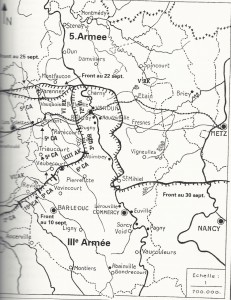
The French 3rd Army front as on Sep 10 , 1914 (© Amis de Vauquois)
September 24, 1914
In order to increase pressure on the resupply of the Verdun fortified area, a new offensive is launched by the German 5th Army. Vauquois Hill is heavily shelled and the French troops have to withdraw after suffering 200 casualties. Simultaneously, the German assaults reach the Meuse River at Saint-Mihiel. Verdun is in great danger, but the French manage to contain the threat: the first battle of Verdun is won. However, the Germans hold a strong defensive line and Vauquois is a key position, as it allows directing artillery fire on the railway between Paris and Verdun. Therefore, the German engineers start to fortify the ruins of the village and the southern slope of the hill, transforming the ridge into a strong fortress.
October 1914 – February 1915
On October 28 is conducted the first French attempt to regain control of the village. Three unsuccessful infantry assaults are launched during three days by the 10 FR ID. After six weeks of reorganization, a new attempt is performed on Dec 8, then on Dec 20. Each time, the French infantrymen manage to reach the summit, but are repelled down the hill by German counterattacks, suffering hundreds of casualties.
February 17 – March 4, 1915
After the battle extension in the Argonne forest, the French 5th Corps under Maj Gen Micheler is tasked to regain control of the lost observation points including Vauquois, thus supporting the simultaneous first Champagne offensive. 10 infantry battalions are committed on Feb 17, despite dreadful weather conditions, with the support of 2 Engineer companies, which has dug 6 mines under the German lines (25-50 kg of black powder). After a costly failure, the attack is resumed on Feb 28 with a massive support of artillery fire. During five days of combat, the continuous efforts of the 10 FR ID manages to weaken the German resistance, with the cost of 4,000 casualties. The village is captured and lost four times.
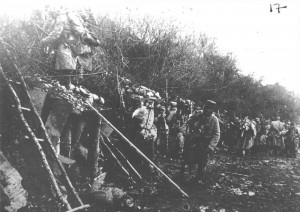
French troops gather down the hill prior to the assault on March 5, 1915 (© Amis de Vauquois)
Mid-March 1915
After additional assaults, the French manage to hold their positions in the southern half of the village, while the Kronprinz sends reinforcements to keep the northern half. As everywhere along the Western front, trench warfare is now the rule. But in Vauquois the no man’s land is just a few meters wide. Field artillery fire is therefore no more efficient. As in other parts of the front, small trench mortars will have to be developed to reach targets at short distance.
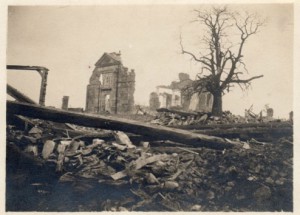
The ruins of the church and the chestnut tree, as seen from the French lines (© Amis de Vauquois)
Mid-March 1915 to mid-May 1916
Resupplied with many young conscripts, the French infantry regiments are tasked to consolidate their lines. On March 23, a German night attack is repelled despite the use flame throwers. On June 5, the French will replicate the same attempt, without any success as well.
Conducting infantry assaults is now pointless. The mine warfare turns to be the main course of action for both adversaries.
German pioneers and French sappers will now lead combat operations by digging gallery after gallery thanks to a favorable nature of rock. From their own positions, they dig combat galleries going under the adversary lines, ending with mine chambers which are loaded with increasing amounts of explosives: one ton, two tons, ten tons, twenty tons…. Gradually, the former village disappears in the mine warfare and huge connected craters mark the front line, denying any infantry assault. For both sides, the aim is just to maintain pressure on the opponent.
May 14, 1916 - 16.10 hours
On Feb 21, the Germans initiate the battle of Verdun. After initial successes and the capture of the Douaumont fort, their offensive meets fierce defense from the French 2nd Army under Maj Gen Pétain. Pressure is to be maintained along neighboring fronts in order to hamper any French reinforcements.
After four months of preparation, the most powerful mine during the whole war detonates under the French lines. It was loaded with about 60 tons of Westfalit. 108 French “poilus” are reported missing in the 80-meters-wide and 40-meters-deep crater and the whole western edge of the hill is devastated.
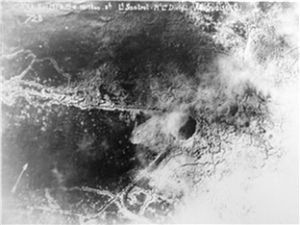
A French aerial picture of the crater caused by the biggest mine of the war, as seen on June 19, 1916 (© Amis de Vauquois)
Summer to winter 1916
As a link with the on-going operations in Verdun and the Somme, the climax of the mine warfare is reached with numerous explosions of mines. Both opponents develop improved techniques, digging deeper and deeper by starting galleries right from the flanks of the hill, in order to protect the works from mortar fires. On Aug 19, a 12-ton mine is blown up by the French engineers near the church. As an answer, a new big German mine detonates on Dec 10 under the Eastern edge of the ridge; about 50 men are removed from the debris but 21 are reported missing. Accidents also create casualties, such as on Dec 31, when 36 French “poilus” are killed while loading a 22-ton mine.
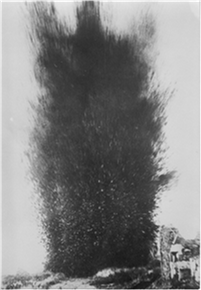 Explosion of a mine (© Amis de Vauquois)
Explosion of a mine (© Amis de Vauquois)
1917
With the development of new observation assets (aircraft, balloons), the control of Vauquois summit is no longer a priority. The French develop a plan to blow up the whole hill with 3 mines, dug 45 meters below the surface and loaded with 145 tons. On their side, the German engineers conduct a similar project by digging 3 galleries down to 110 meters. But both projects are not completed due to lack of manpower and shortage of ammunition. On both sides of the hill, works on new galleries stop. From now on, only the maintenance of existing networks will be performed. Pressure will be maintained by 2 to 8-ton camouflets. Due to the density of galleries in the hill, a few underground contacts between opposing sappers occur.
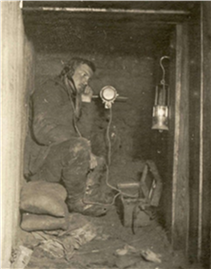
A German sapper listens to some French on-going works (© Amis de Vauquois).
April 9, 1918
The last German camouflet detonates in Vauquois Hill. This is the last one. The very last French mine was blown up on March 21.
June – July 1918
Vauquois has become a secondary front. Both adversaries need troops to be committed in other combat areas, and set up projects to blow up the whole hill. On their side, the French start to fill some galleries with barbed wire and sand bags.
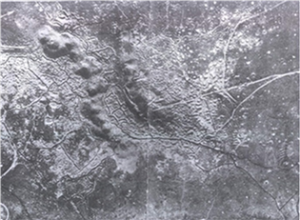
Vertical view of the hill in 1918 (© Amis de Vauquois)
26 septembre 1918
The Meuse Argonne offensive is launched by the US 1st Army Corps under Maj Gen Liggett. While the 28th US Division (28 US Div)[2] is to breakthrough in the Aire valley, the 35th US Div envelopes Vauquois Hill after an artillery preparation of 40,000 rounds. The outnumbered German defenders resist to their last cartridge during 4 hours. The “Doughboys” of the 139th Infantry Regt wipe out all the remaining trenches and discover the amazing sight of the line of craters, where used to stand a typical Meuse village.
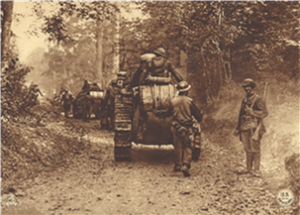
236th Tank battery (28th US Div) moving up front near Boureuilles, Sept 26 (source: US official pictures).
After the war
Due to the threat of unexploded shells and mines, the former Vauquois villagers are denied the access to the village location, which is cleared by American troops. In the frame of post-war governmental policy to classify devastated areas of the front, a portion of the hill is registered as “war vestige”. With the support of the city of Orleans, for numerous of its citizens fought and died on the slopes of Vauquois, a new village is built down the hill from 1920, with wooden structures, to accommodate about 40 determined villagers.
In 1923, a military cemetery is established to gather 4,368 bodies of French soldiers of all ranks (roughly half of those who were reported killed in action in the Vauquois area between Sep 1914 and Sep 1918).
On June 20, 1926, is inaugurated the Vauquois Memorial to those who fought and those who died on Vauquois Hill, designed by Marius Roussel, a true veteran of the battle.
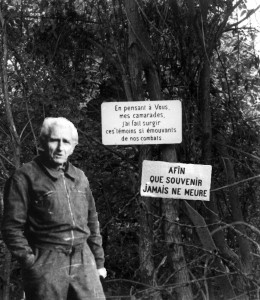
Hilarion Platz, a French veteran of the 46 Infantry, came back when he got retired, and dedicated is retirement to his brothers in arms, to “show moving evidence of their combats, so that memory never fades” (© Amis de Vauquois).
[1] AK : Armee Korps (German Army Corps).
